Although the EMT® Program is a highly educational and rewarding experience in its own right, it is designed with real-life emergencies in mind. Below, five pilots describe emergency scenarios they encountered some time after participating in the EMT® Program.
These stories share a number of common traits: they involve real pilots, flying real airplanes, in real emergencies. While the successful outcomes described below cannot be attributed solely to the techniques taught in the EMT® Program — piloting skill, knowledge of the airplanes and procedures, judgment, proficiency, etc. are all involved — the pilots do acknowledge the role EMT® played during the emergencies.
Scenario #1 – Engine Failure during Takeoff
Jim Skogen from Minnesota e-mailed:
I’m at the keyboard trying to write about my engine out experience and how it relates to your EMT® program. I’ve also reread the power plant failure chapter in your book. It’s all very good material and relates to the engine out in my T-34. Even though I have practiced and instructed others what to do with power loss on climb out, that natural urge to make it back to the runway remains very strong. But with simulated engine out practice, a pilot can learn the visual references that will indicate if the runway truly is within glide range.
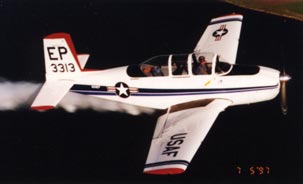
Jim’s beautiful T-34 w/ smoke on
We have been using the 180-degree power off glide to the runway exercise along with 360 overhead approaches in the T-34. Both maneuvers are good ways to establish and trim for best glide speed, while visually memorizing the sight picture needed to make the runway. The instant a pilot realizes that the runway cannot be reached, quick actions are needed to select an alternate landing site.
Practice is the only way to develop the visual cues. Most of the EMT® lessons end with 180-degree, power off glides to the runway — an excellent way to develop and to keep current with the skills required to glide to a runway. Practicing this glide-to-the-runway with students was a key element in the successful end to my engine failure. Establishing best glide speed by pushing the stick forward and trimming to maintain it was automatic for me.
All the topics in your book, including wind, bank angle, best glide speed, spot, set-up are important, but practicing those procedures is most important. In my situation, it was only 45 seconds to a minute from hearing the bang until I touched down on the runway. There is very little time to think, you just have to react. Making the right reactions can only come from practice, and staying current in the procedures.
It has been a little difficult to write of my engine out experience. As I try to remember the order of things, my heart still starts to race and the order of things all seem to run together. I must say from the start that the things I did were more reactions than a conscious thought process, thanks to repeated practice with the procedures.
It was a Sunday afternoon in May with a south wind at 15 knots. I pulled the T-34 out of the hangar, thinking that the plane had been running exceptionally well lately. It was just going to be a local flight around the farms, maybe 45 minutes. Departing runway 16, I climbed straight out and turned right 45 degrees to depart the pattern. At this point, I was 800 ft AGL and maybe 3/4 mile off the runway. I started to bring back the prop for cruise-climb, setting up for 100 knots when I heard a loud bang. I was not sure where it came from and thought I had hit a bird.
Immediately a vibration started and I smelled smoke. I knew I was in trouble and did not want to believe this was happening to me — fear and panic for a split second. Without even thinking, I had already turned another 45 degrees to the right. Talk about the strong instinct to get back to the runway! I tried adding power, but the vibration only worsened. So I just left the throttle alone while establishing the best glide speed of 90 knots.
At this point, I realized it might be best to make an off airport landing. I took a quick glance to the end of the runway and noticed it was under the imaginary “glide” arc around the cowling, indicating it was within gliding distance. The prop was still turning but the engine was producing no power. Turning directly to the runway from my present position, I would intercept the extended centerline at about a 30-degree angle. There was no relative motion between the runway numbers and a spot on my windshield, indicating I was going to make it. While glancing to check best glide speed, I also noticed the oil pressure needle dropping to zero.
I crossed the end of runway at 20 feet, put the gear down, and turned the last 30 degrees to line up with the centerline. With a 15-knot tail wind and still gliding at 90 knots, I was using up a lot of runway. At this point I wanted to get the plane on the ground — I used no flaps and I forced the airplane onto the runway, applying hard brakes. I came to a stop about 3/4 the way down the runway and noticed the prop had stopped.
My heart was really pounding now and I wanted to get out of the plane. After making sure there was no fire, I noticed oil streaming down both sides of the plane into puddles on the runway. There was no one else at the airport that day, but a car stopped on a nearby road. I waved at the car and he drove off. I walked up to the hangar, got my tow bar and rope, and pulled the plane off the runway with my pickup. It was then that I realized I had made a successful engine out landing.
A piston had cracked and separated from the connecting rod. The connecting rod then came through the crankcase allowing the oil to exit the engine.
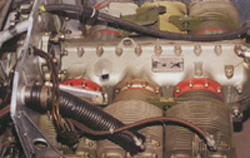
The hole blown in the crankcase
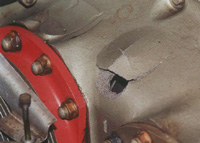
Close up
Scenario #2 – Unintentional Flat Spin
The October 1992 issue of Sport Aerobatics magazine published the following, which was submitted by an IAC member from Indonesia:
Enclosed photo shows the broken throttle Teleflex of our Pitts S-1E, caused by improper installation. The incident occurred while performing aerobatics at 3500 feet AGL. While entering an inverted spin from inverted the pilot noticed that despite closing the throttle, the aircraft’s speed did not bleed off as quickly as normal. Not noticing that partial power existed, despite closed throttle, the pilot continued entry into the spin by holding the nose higher to bleed of speed.

The broken Teleflex from the Pitts
Somewhat surprised by the resulting inverted flat spin, the pilot initiated recovery using Rich Stowell’s PARE® system:
Power : off
Aileron : neutral
Rudder : opposite
Elevator : thru neutralThe problem which caused delayed but eventual recovery was that closing the throttle did not take power off because of the broken Teleflex. If the pilot had been able to recognize that partial power was stuck on, he should have pulled the mixture. However, having taken Rich Stowell’s EMT® course, the pilot was confident in his spin recovery control inputs and held them in despite the delay in recovery. Had the pilot been in doubt and reversed his control inputs, he would have become another “spun in” statistic.
Scenario #3 – Stuck Elevator Control during Hammerhead
Jim Cunningham from California wrote:
After completing the EMT® and Aerobatic course with Rich Stowell I purchased a Great Lakes Biplane. Some time later, while performing a hammerhead turn over the local aerobatic area, the course paid for itself many times over.
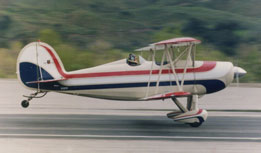
Jim’s Great Lakes on takeoff
I executed the hammerhead the same as I had on many previous occasions, with a full power 90-degree climb. At the top of the maneuver, left rudder, forward elevator, and right aileron are applied. I make it a habit to retard the throttle after the pivot, once the 90-degree down line is established.
I pulled the stick back to finish the maneuver. When I reached straight and level flight, I attempted to neutralize the stick, but it was jammed. In an instant I went through level flight and continued climbing until I was in a 25-degree climb.
Rich and I had practiced recovery from jammed control surfaces. Two things immediately occurred to me: The first was that I had a jammed elevator; the second was that I knew I could control the airplane in this condition. I immediately retarded the power until the plane was straight and level. I did not want to move the stick because I did not want the condition to worsen. The airport was about seven miles from my present location, so I flew back toward the field controlling pitch (and therefore my altitude) with power only, taking great care not to move the stick.
My home airport is an uncontrolled field, and I was set up for a straight-in approach. However, I felt confident in my ability to control the airplane that I decided to fly a broad, conventional pattern. (In retrospect, I think I would opt for the straight-in approach if I were ever in the same situation again.)
On final approach I continued to control pitch with power. I landed without incident, taxied to my hangar, and shut down the engine. I was still holding the stick in the configuration it was in when it initially jammed. I let go of the stick, and instead of dropping forward, it remained in the same position. Subsequent inspection by me revealed that my small, five-inch flashlight had somehow gotten under the floorboard and tumbled into the back of the airplane. It had jammed the bell crank, immobilizing the elevator.
Scenario #4 – Engine Failure on Final
J.C. from Michigan faxed:
This note is long overdue, but I did want to follow up on the training you provided — with some examples of the practical value I received when you visited Pontiac.First, it wasn’t long after you were gone when I was demonstrating a half loop to someone in the back seat when I fell out into an inverted spin. Other than the extreme increase in heart rate, I PARE’ed it without a problem — my friend thought it was just part of the plan! Two weeks ago, it was my great misfortune to experience engine failure on final (after a great hour of hammerhead practice). Of course I was lined up on the worst runway possible (04), needing to cross the power lines, busy highway, and close fences without any go around insurance. Obviously a good ending BUT it may have been much different had I not been practicing the EMT® techniques you taught and reinforced….
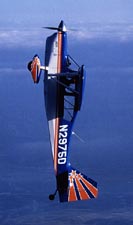
Decathlon before Hammerhead
Scenario #5 – Engine Failure during Cross Country
Claude Stahel from Switzerland e-mailed:
Thanks for saving my life, Rich! Figuratively, you were right there with me when I was flying back home from Paris in February. I was climbing over the last mountain of the trip, about 2000 feet above the ground, listening to some Led Zeppelin on my Walkman. I had just left army-controlled airspace and had dialed Reims into my radio. The throttle was firewalled for the climb, and I was storing away my maps and other gear since I knew the way home from here.Suddenly I heard a metallic ping-ping sound, and it seemed as though the prop was no longer rotating along the airplane’s centerline! I pushed the mixture forward and eased the throttle back an inch hoping for a smoother ride. Things smoothed out all right — the prop immediately stopped! I set the trim of the Cessna 150 full-nose-up, as you had suggested during our training. Then I became aware of the adrenaline rush. It seemed to hit me in a flash. I figured, “Ok, now is not the time to keep listening to my Walkman,” so I pulled the stuff out of my ears. Strangely, my next thought was, “Ok Claude, now you can prove what you learned in the US…”
The terrain in this location is not all that airplane-friendly — lots of forest with some small cow fields at least. I tried to find the nearest airport on my GPS, but got lost in the menus while pushing buttons. I decided to just look around for a field instead. I chose a grassy field to my left, about 1500 feet long. A row of trees along the approach end. Some cows. No powerlines. All-in-all a manageable site. I had a nice tailwind and was too high to begin the approach just yet.
I then made an emergency call to Reims. They asked me if this was a simulated event. “Negative!” My exact position? Oops — I had put away my map.Forget trying to unfold the map now: “I’m between Becancsang and Montbelliard.” By now I was turning the airplane toward my field, but I was still too high. The controller was asking a lot of questions, to the point of distraction. I said, “Sir , I can’t talk anymore. I’ve got to concentrate on landing this airplane.” Silence…
My strategy was to fly to the key point, where I would turn onto the base leg. From there I could make additional judgments about my altitude, with the option either to shorten or lengthen the base leg prior to turning final just as you describe in your book. The airplane was still in the clean configuration. “Speed–spot–attitude” were the only things I was thinking. I remember holding the yoke with two fingers. NOT pulling back was super clear in my head. I did not allow the airspeed to fade one bit below 60. Over the trees I deployed full flaps, pushing the nose down a little before pulling in the flare. I touched down with the stall horn going off, keeping the yoke fully aft for a couple of seconds before applying hard brakes.
I knew that every knot slower during the ground roll would get me on the safer side should the airplane hit a rock or something. The noise of the front wheel bouncing across the bumpy field was extreme. Even the ELT went off. The cows got bigger in the windscreen, but thankfully I got stopped before hitting any of them.
I called the tower by mobile phone to close my flight plan, asking them to call Reims to let them know everything turned out great. Thanks for helping me understand glide dynamics — without this knowledge, my decision-making could have been fatally flawed.
That’s my story. I hope my experience helps other pilots. P.S.: Now I have a Maule.
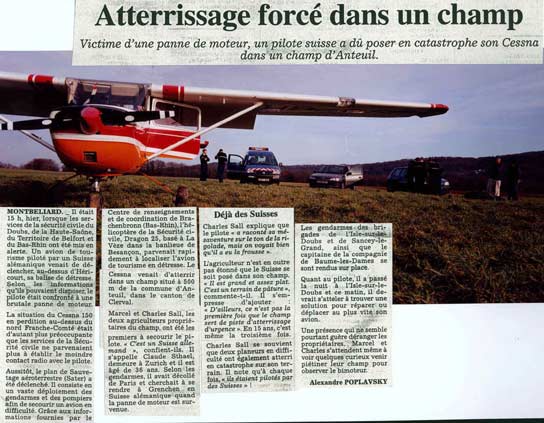
Claude’s off-airport landing makes the local paper
